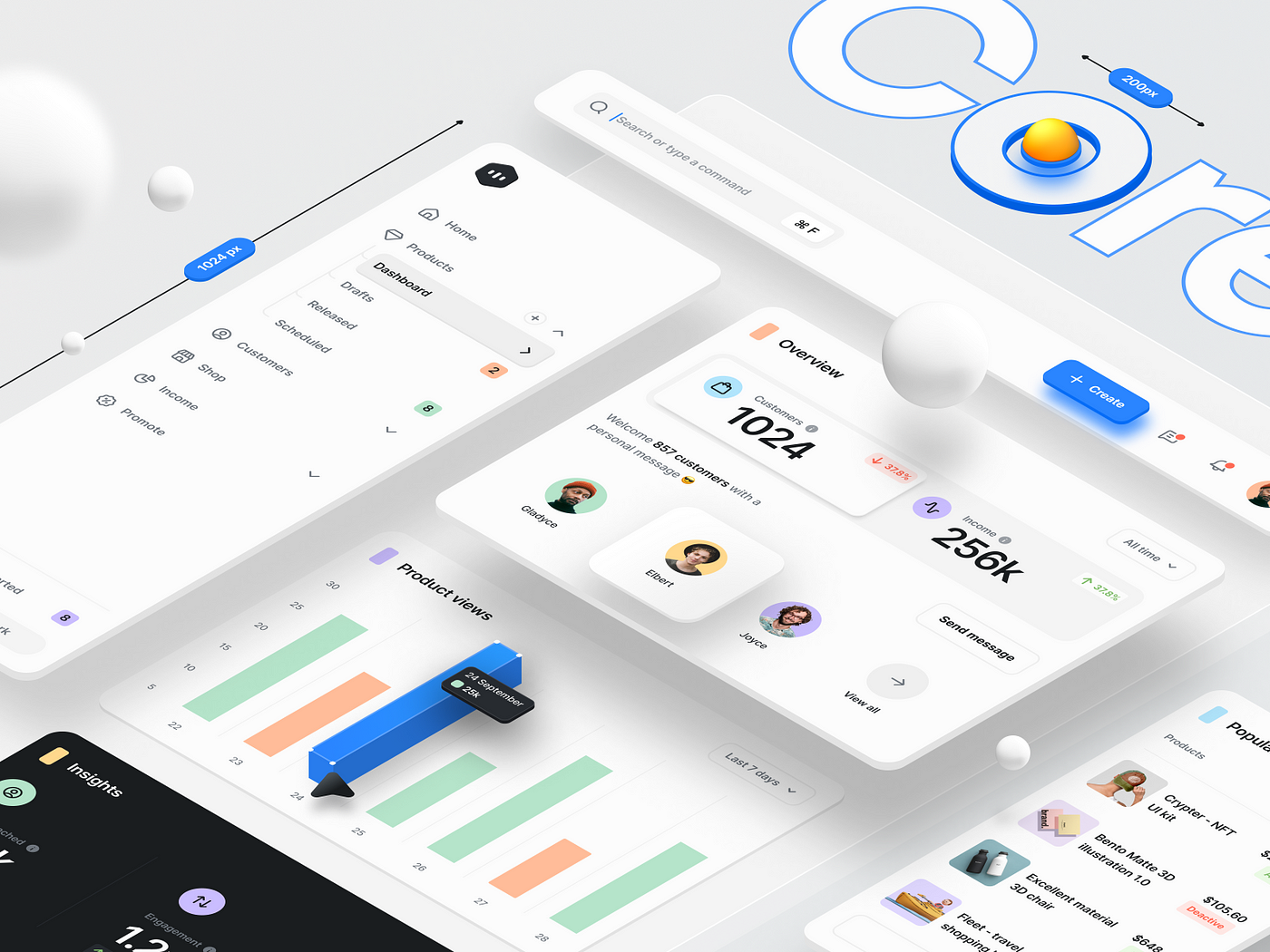Core App Dashboard : Navigating the Digital Landscape

In the rapidly evolving landscape of technology, applications (apps) have become an integral part of our daily lives. From managing tasks to connecting with friends, apps offer convenience and efficiency like never before. With the proliferation of apps across various platforms, the need for effective management and monitoring has led to the emergence of a crucial element: Core App Dashboard. Serving as the nerve center for both users and developers, the core app dashboard plays a pivotal role in navigating the digital landscape.
I. The Essence of App Dashboards
At its essence, an app dashboard is a centralized interface that provides users and developers with insights, control, and an overview of app-related activities. It serves as a command center, offering a streamlined experience that enhances user interaction and simplifies the complex processes happening behind the scenes. Whether it’s a fitness tracking app, a project management tool, or a social media platform, dashboards have become synonymous with user-friendly navigation and efficient data management.
II. Empowering the User Experience
User-centric design lies at the heart of effective app dashboards. These interfaces are meticulously crafted to ensure users can effortlessly access and manage the features they need. The dashboard’s layout, color scheme, and information hierarchy are tailored to create an intuitive experience that minimizes the learning curve. Key components of an app dashboard include:
- Data Visualization: Dashboards present data in a visual format, using charts, graphs, and infographics. This simplifies complex information, enabling users to comprehend trends, patterns, and insights at a glance.
- Customization: A well-designed dashboard allows users to personalize their experience. They can often rearrange widgets, select preferred metrics to display, and set up notifications based on their requirements.
- Navigation: Navigation is simplified through clear menus, icons, and links. Users can seamlessly transition between different sections of the app, enhancing their overall experience.
- Task Management: Dashboards frequently include tools for task and activity management. This can range from marking items as complete in a to-do app to scheduling posts in a social media management platform.
- Performance Monitoring: For users, app dashboards can display personal statistics and achievements. For developers, they provide insights into app performance, highlighting areas for improvement.
III. Behind the Scenes: Developer Control
While app dashboards primarily cater to users, developers also benefit significantly from their functionality. The core app dashboard empowers developers to monitor, analyze, and fine-tune their applications for optimal performance and user satisfaction. Key aspects of developer-oriented dashboards include:
- Analytics: Dashboards provide developers with comprehensive analytics on app usage, user behavior, and performance metrics. This data is invaluable for making informed decisions on updates and improvements.
- Bug Tracking and Feedback: Users often report bugs or provide feedback through the app dashboard. Developers can use this information to identify issues and implement fixes promptly.
- Version Control: App dashboards facilitate version control, enabling developers to manage different versions of their apps efficiently. This is crucial for maintaining stability and introducing new features seamlessly.
- Security: Developers can monitor the security of their apps through dashboards, identifying potential vulnerabilities and responding to security breaches in real time.
- Server Management: For apps that rely on cloud services or remote servers, dashboards offer insights into server performance, uptime, and potential bottlenecks.
IV. The Evolution of App Dashboards
As technology continues to advance, app dashboards evolve in tandem. Machine learning and artificial intelligence are being integrated into dashboards, enabling predictive analytics and proactive suggestions for users. Personalization has reached new heights, with dashboards adapting to individual preferences and habits.
Furthermore, the concept of cross-platform dashboards is gaining traction. With users accessing apps on various devices and platforms, having a consistent dashboard experience across all of them enhances user engagement and loyalty. This trend underscores the growing importance of responsive design and adaptable interfaces.
V. Challenges and Future Directions
Despite their many benefits, app dashboards also present challenges. Balancing simplicity with functionality can be a delicate task, as an overly complex dashboard might overwhelm users. Data privacy and security concerns require careful attention, particularly when dealing with sensitive user information.
Looking ahead, the future of app dashboards holds exciting possibilities. The integration of virtual and augmented reality could lead to immersive dashboard experiences, where users interact with their apps in entirely new ways. Additionally, the ongoing refinement of natural language processing could enable voice-activated dashboards that provide a more conversational and intuitive interface.
VI. Conclusion
In the dynamic world of applications, the core app dashboard serves as a critical bridge between users and developers. It empowers users to engage with apps effortlessly while granting developers the tools they need to create, optimize, and maintain these digital experiences. The evolution of app dashboards mirrors the broader technological landscape, adapting to new challenges and embracing emerging trends. As we continue to navigate the digital realm, the app dashboard remains a steady guide, enriching our interactions and shaping the way we engage with technology.
FAQs on Core App Dashboard
Q1: What is a core app dashboard?
A1: A core app dashboard is a centralized interface within an application that provides users and developers with a visual overview of app-related activities, data, and controls. It simplifies user interactions and offers developers insights into app performance and management.
Q2: How does a core app dashboard enhance user experience?
A2: A core app dashboard enhances user experience by providing an intuitive interface for accessing app features and data. It offers data visualization, customization options, easy navigation, and task management tools, making it easier for users to interact with the app’s functionalities.
Q3: What are the key components of a user-centric app dashboard?
A3: A user-centric app dashboard typically includes components such as data visualization elements (charts, graphs), customization options (rearranging widgets), clear navigation menus, task management tools, and personalized performance monitoring features.
Q4: How does a core app dashboard benefit developers?
A4: Developers benefit from a core app dashboard as it offers analytics on app usage, user behavior, and performance metrics. It provides bug tracking and feedback collection, version control, security monitoring, and insights into server management. These features aid developers in maintaining and improving their applications.
Q5: Can app dashboards adapt to different devices and platforms?
A5: Yes, app dashboards can adapt to different devices and platforms through responsive design. A well-designed dashboard ensures a consistent user experience across various devices, such as smartphones, tablets, and desktops.
Q6: How are machine learning and AI integrated into app dashboards?
A6: Machine learning and AI are integrated into app dashboards to provide predictive analytics and proactive suggestions for users. These technologies analyze user behavior and data patterns to anticipate user needs and provide personalized recommendations.
Q7: What is the future of app dashboards?
A7: The future of app dashboards holds possibilities like immersive experiences through virtual and augmented reality, voice-activated dashboards using natural language processing, and enhanced cross-platform compatibility for a seamless user experience.
Q8: What challenges do app dashboards face?
A8: App dashboards face challenges in balancing simplicity with functionality, ensuring data privacy and security, and adapting to rapidly evolving technology. Overwhelming users with complex interfaces and handling sensitive user data are ongoing concerns.
Q9: How do app dashboards contribute to app security?
A9: App dashboards contribute to app security by providing developers with insights into potential vulnerabilities and breaches. They allow for real-time monitoring of security-related events and data breaches, enabling prompt responses to threats.
Q10: Are there tools available for creating app dashboards?
A10: Yes, there are various tools and frameworks available for creating app dashboards. These tools provide pre-built components, templates, and customization options to streamline the dashboard development process.
Q11: What role do app dashboards play in user engagement?
A11: App dashboards play a crucial role in user engagement by offering a user-friendly interface that helps users access and manage app features effortlessly. Engaging data visualization, notifications, and personalized recommendations enhance the overall user experience.
Q12: How can developers use app dashboards to prioritize updates?
A12: Developers can use app dashboards to prioritize updates by analyzing user feedback and usage data. They can identify pain points, popular features, and areas that need improvement, allowing them to allocate resources effectively for updates.
Q13: Can app dashboards help in identifying app performance issues?
A13: Yes, app dashboards provide developers with performance metrics and analytics that help identify app performance issues. Developers can monitor factors like app responsiveness, loading times, and server performance to enhance user experience.
Q14: Are app dashboards only for large applications?
A14: No, app dashboards can benefit applications of all sizes. Even smaller apps can use dashboards to offer users insights, customization options, and efficient ways to interact with the app’s functionalities.
Q15: How do app dashboards contribute to user retention?
A15: App dashboards contribute to user retention by providing users with personalized experiences, easy access to relevant information, and the ability to manage tasks efficiently. A well-designed dashboard enhances user satisfaction and encourages them to continue using the app.
App dashboards have evolved into essential tools that bridge the gap between users and developers. They provide a multifaceted solution for enhancing user engagement, simplifying data management, and ensuring the smooth operation of applications in today’s dynamic digital landscape.






